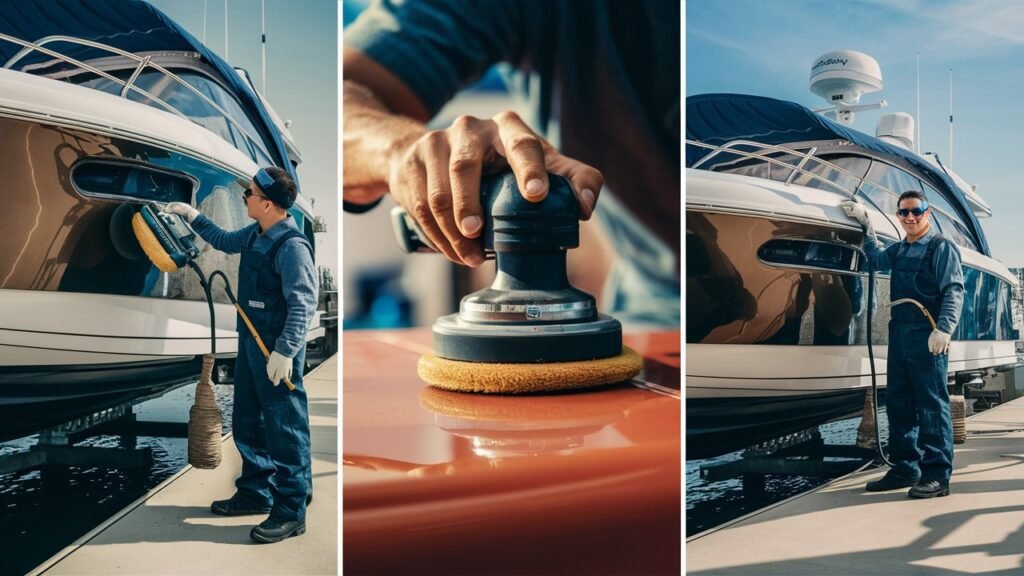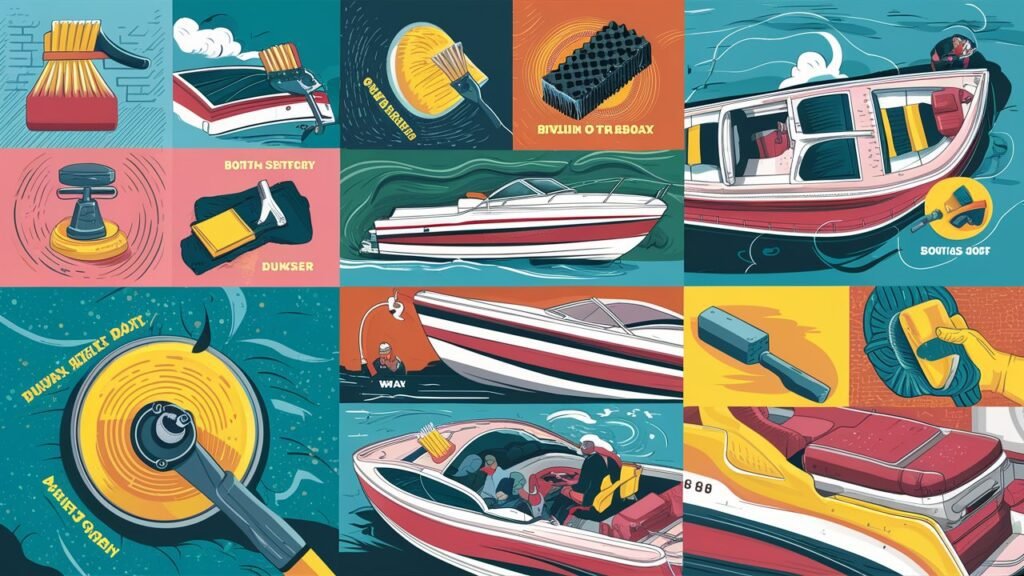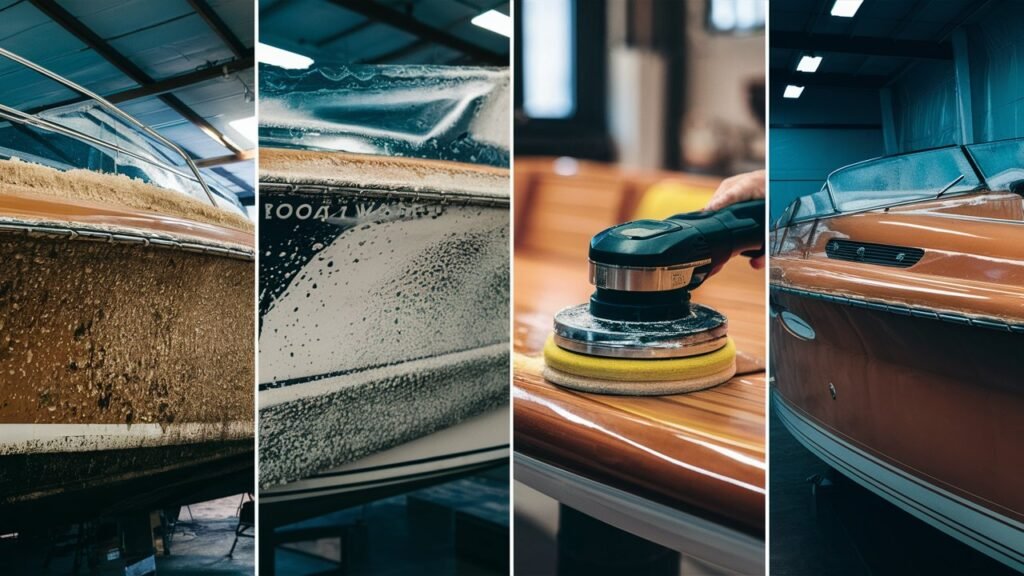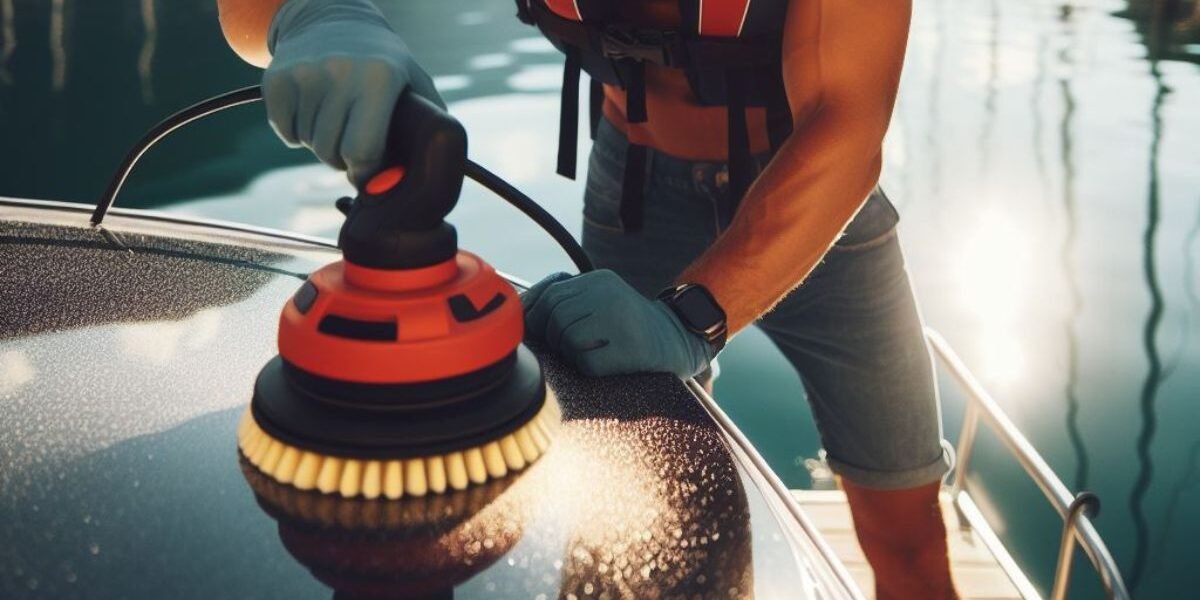How to Wax a Boat with a Buffer?
Waxing your boat with a buffer can be an efficient way to keep your fiberglass boat looking its best.
Before you begin, make sure to wash and wax your boat to remove any grime or oxidation.
Once the surface of the boat is clean, you can start the buffing and waxing process.
Using a compound to buff the gelcoat can help to remove any oxidation and restore the shine to the surface of the hull.
It’s important to use a marine wax specifically designed for fiberglass boats to protect your boat from the elements.
Using a rotating buffer or an orbital buffer makes work easier as well as ensuring that wax is applied uniformly.
Allow the wax to dry after application then use a boat polisher to make it shine bright.
To wax your boat using a buffer, you should use cleaner wax in the beginning so as to get rid of stubborn stains and oxidation.
In order to polish your boat properly, follow the manufacturer’s advice on how it should be done.
For boats that are quite old and have oxidized extensively, rubbing compound may be necessary before waxing can begin.
Buffing requires some hard work so be prepared with enough effort if at all you want your boat to look its best again.
You will need elbow grease when buffing your boat; therefore, do not hesitate but give all your energy until it shines like new!
With regular waxing and buffing of your boat, it shall always appear new while guarded against water damages.
Why is Waxing a Boat Important?

Regularly waxing your boat is very important to keep up its look and prevent sun harm on the hull.
As a boat owner, you should know the importance of investing in right products like boat wax or hull cleaner.
While it’s essential to wash your boat regularly, applying a thin layer of wax after that is the best way to protect the gelcoat.
The most proper method for waxing a boat is by working on one section at a time with either dual-action boat polisher or good buffer.
Once you have applied the wax, turn on the buffer and work it in circular motion so as to buff out gelcoat and remove any imperfections present.
After using buffer, you need buff off wax coat with soft cloth.
If there are areas with special lettering or details, it might be better not use buffer but apply this product manually.
Protecting Your Boat’s Surface

In terms of its appearance and durability, preserving the surface of your boat is very important.
Regularly washing and polishing or waxing the surface is among the most effective methods to protect a boat.
Start by cleaning the boat thoroughly with a mild detergent and soft wash mitt to remove chalky oxidation and other marks.
When you have finished washing the boat, apply boat polish or wax as recommended, usually by hand.
Wait for some time before buffing off the product by hand to expose a shiny protected surface that will stay looking good for years.
This not only beautifies your vessel but also makes it much safer and easier to operate since decals or protruding hardware are less likely to be damaged.
The last stage of safeguarding against any remaining residue on your boats’ surfaces involves removing them so that they can remain immaculate.
For larger areas, use a power buffer; while for smaller sections, it can be done simply by hand buffing.
Take care around any decals or special lettering so as not to damage your hull. Your boats’ surfaces will become safer and more user-friendly through regular compounding efforts combined with correct maintenance just like hydroplaning cars on water do.
Discover how best to protect your boats’ surface today and enjoy a bright protective finish throughout many future years!
What Tools and Materials Do You Need to Wax a Boat with a Buffer?
Prepare for buffing your boat by getting some necessary materials and tools.
Initially, find a good waxing machine suitable for sea-going vessels.
Besides, if you don’t want to use the buffer, you will need a sponge or a cloth for spreading the wax.
Then, choose a compound which will be compatible with gel coat of your boat.
To begin with, wash your boat properly so as to remove all dirt and debris.
After washing the boat, apply wax either by hand or using the buffer depending on what you like most.
Allow the wax to dry for few minutes then remove any excess with clean cloth by rubbing it off.
The final outcome is a shiny surface that is not only functional but also aesthetic.
Buffer or Polisher Selection

While choosing a specific work, it is necessary to give attention to the kind of surface.
Most buffers are in use for broad, smooth floors like countertops or hardwood. On the other hand, polishers work best on small curved surfaces such as furniture or car bodies.
It is also important to consider how fast and powerful your tool needs to be based on what material you’re dealing with.
For instance; some finishes are so fragile that they cannot withstand high-speed buffers while others may not respond well when worked upon by low power polishers made for hard materials.
Another thing to think about is the size and weight of your machine so that it can be used comfortably over long periods of time.
Cleaning Supplies
There are some fundamental factors that you need to think about when choosing a buffer or polisher for your car.
Start with the size and power of the machine.
To polish such surfaces effectively, bigger automobiles or those with heavily scratched paint will require a stronger buffer.
Also, look at the speed settings of that machine – variable speed is best because it can deal with different imperfections.
The type of pads that will be used with this device also matters a lot.
Each pad has been designed for certain tasks like cutting through deep scratches or applying fine polish finishes onto cars’ bodies
Lastly always safety comes first so use appropriate protective clothing items and follow all instructions given by manufacturers.
Step-by-Step Guide to Waxing Your Boat with a Buffer

Step-by-Step Guide to Waxing Your Boat with a Buffer
Prior to Anything Else:
Initially, wash the ship completely so that all dirt, dust or salt is eliminated.
Utilize a boat wash soap with water for removing anything that has stuck onto the surface.
Thoroughly rinse off the boat and wait for it to dry completely before proceeding with the next step.
Putting on Wax:
Opt for a good quality marine wax and put a little amount on the buffer pad.
Spread out this wax evenly over the entire body of your vessel working in small areas at once.
Ensure that you select a lower speed setting on your buffer so as not to harm gel coat finishes while applying polish
Polishing Surface:
Once applied uniformly switch buffers onto higher rates then buff around in circles till shiny finish appears through
Buff until shiny finish appears through after being absorbed into gel coat entirely by waxing evenly throughout
Final Touches:
Use clean microfiber cloth after finishing whole boat if there are any extra residues left behind they should be wiped off using soft fiber clothes which will leave outer parts more glossy than before thus protecting them effectively against harsh weather conditions
Preparing Your Boat’s Surface

Preparing Your Boat’s Surface
To make it certain that maximum adhesion and longevity of the finish are achieved, you should first ready the surface before applying any paint or other protective coatings to your boat.
Start by cleaning the whole boat using a marine-safe detergent so as to eliminate all dirt, grime and salt buildup.
Next, sandpaper or a sanding machine could be used for smoothing out rough or uneven areas in order for paints to stick well onto them.
Remove any old paints or coatings that might be peeling off or flaking before application of new ones.
Lastly, apply primer which will seal surfaces and make them strong enough for bonding with paints.
Preparing surface properly will give your vessel an attractive appearance which can last for many years without getting damaged.
Applying the Wax in Circular Motions
One common technique when waxing various surfaces is to apply the wax in circular motions.
This approach guarantees uniform distribution of the wax and aids in buffing the surface to a sleek finish.
It’s important to do small sections at a time, using a cloth or applicator pad to apply the wax in circular motions.
Doing this prevents streaks or uneven coverage. By working in circles, you also spread the wax evenly and allow any surplus get absorbed properly.
Moreover, this method can enhance the overall shine and durability of the finished surface by giving it a more professional look that will stand out for longer.
In general, applying wax with circular motions is an easy yet effective way of achieving good results when waxing different types of surfaces.
Buffing and Polishing for Shine

Buffing and polishing refer to ways of making the surface shinier and smoother.
Buffing is done by applying a polishing compound onto an object using a rotary tool or machine, while polishing is the process where pressure and friction are applied to remove imperfections and create a glossy finish.
The most common use of these methods is on metals like chrome or stainless steel which have become scratched or lost their lustre.
They can also be used on painted finishes, removing swirl marks and bringing out deeper colours as well as improving their shine.
Whether it’s a DIY job around the house or professional car detailing, you can’t skip buffing & polishing if you want your end result to look great.
Common Mistakes to Avoid When Waxing a Boat

When waxing a boat, people often make mistakes that are generally easy to avoid if they take enough care and give attention to details.
It is important to put on wax in small portions and buff it out completely so as to achieve a smooth, shiny finish.
Another mistake is using an inappropriate kind of wax for the surface of your boat.
For long-term protection against weathering agents, always use marine-grade wax.
Also, failure to clean and dry the boat properly before applying wax may leave you with a dull look or even damage the surface.
Lastly, haste during waxing can result in uneven application with some areas being left out altogether.
Therefore be patient and work methodically for better outcomef.
One such common mistake involves putting too much amounts of wax at once which may cause steaks or cloudiness.
Skipping the Cleaning Step
When you are pressed for time or tired, it is very easy to miss the cleaning step in any job.
However, failing this crucial step may result into dirt, grime and bacteria gathering that can be hazardous both to your health and the life span of whatever you don’t clean.
The outcomes may be severe whether it is skipping a skincare cleansing phase or leaving your living area unattended for quite some time.
More so, not only does skipping the cleaning step make an environment less hygienic but also affects how things look and work when they are not attended.
For instance, if you skip cleaning during car maintenance; dust will accumulate onto surfaces within thus leading to wear out as well as interfering with its operations sometimes even affecting performance.
conclusion
To summarize, using a buffer to wax your boat is an important part of keeping it looking good and safe from weather damage too.
If you stick with step-by-step instructions and have the proper supplies handy, then you can create a shiny finish that protects well enough to last many more years.
Still, don’t make errors like overdoing it on wax or forgetting this first stage of cleaning or choosing an incorrect kind of wax.
With proper care and attention to detail, you can ensure that your boat stays in top condition and continues to provide you with many enjoyable boating experiences.
Remember, investing time in proper maintenance now can save you time and money on repairs in the future.
So, take the time to wax your boat properly and enjoy the rewards of a beautifully maintained vessel on the water.




